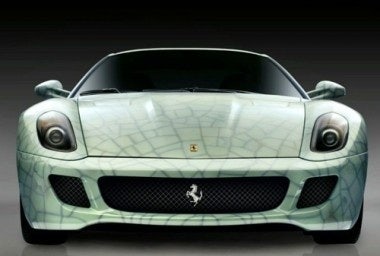One-Off Edition, Inspired By Ancient Chinese Pottery And Designed By Contemporary Chinese Artist Lu Hao, Sells To Shanghai-Based Bidder#

A few weeks ago, we wrote about the collaboration between Ferrari and Chinese artist Lu Hao on a one-of-a-kind model of the company's localized Ferrari 599 GTB Fiorino China (limited to a run of only 12), set to be auctioned off for charity. Featuring unique accents like a carved jade ignition button and ancient xiaozhuan script inscriptions on the inside and a distinctive trompe-l’œil paint job incorporating the faint green hue and cracked pattern of Ge Kiln porcelain from China’s Song Dynasty, the Lu Hao Ferrari is an example of the intensive localization efforts that even the world's top luxury brands are employing to capture market share on the high end while building long-term brand loyalty among the emerging monied class.
According to China Daily, this week the Lu Hao Ferrari sold at auction to an anonymous Shanghai-based bidder for US$2 million, with the proceeds going to fund engineering students and teachers from Bejing's "ivy league" Tsinghua University to study in Milan and at Ferrari's headquarters. From the China Daily piece:
Michael Schumacher had previously unveiled the car designed by Chinese artist Lu Hao and decorated with Song Dynasty (960-1279) Ge Kiln pottery patterns. "It is a very good mix of Chinese inspiration, an artist's eye and Italian technology," said the seven-time Formula One champion.
The 40-year-old Lu is one of China's most influential contemporary artists. His works have been collected in many museums around the world, including the Museum of the University of Cambridge, the Ullens Center for Contemporary Art, and the Singapore Art Museum.
The light blue-colored body of the car looks like a patchwork of jade fragments, with all the characters on the dial and buttons done in xiaozhuan, an archaic form of Chinese calligraphy.
"This work embodies my understanding of the essence of Chinese culture and the Ferrari brand," said Lu.
His commission began when Ferrari decided to make a special model for its Chinese customers this May, and approached Lu. Lu said he had nothing in mind when he got the assignment. One night, after work, he strolled into a small restaurant near his apartment. He asked the waitress to pass him an ashtray and noticed its Ge Kiln pottery pattern. "Suddenly, I knew what I should do."
"There are less than 300 works of Ge Kiln pottery in the world, and each of them is priceless. I wanted to show this," says Lu. He took just five minutes to explain what Ge Kiln pottery is, and why the Chinese love jade and its culture. To his surprise, the Ferrari staff thought highly of his ideas and accepted them enthusiastically.
Lu says he has always wondered why numbers and pamphlets in a car sold in the Chinese market were in foreign nomenclature.
Taking his chance, Lu changed all the Arabic numbers on the dial in the Ferrari car into xiaozhuan. "Why should these buttons be in English, and those numbers in Arabic? I was determined to change all the foreign elements into Chinese this time," Lu says. He used xiaozhuan, he says, because it is a "language known to those who have a deep understanding of Chinese culture".
Although Lu Hao may be overestimating the familiarity most Chinese have with the archaic xiaozhuan script, he's on the right track with this project, and he's right in noting that intensive cultural localization will be the wave of the future in China. Ferrari has probably noticed this, and it would serve other high-end luxury brands to start looking into this as well, if they plan to compete with future Chinese luxury brands on their home turf.